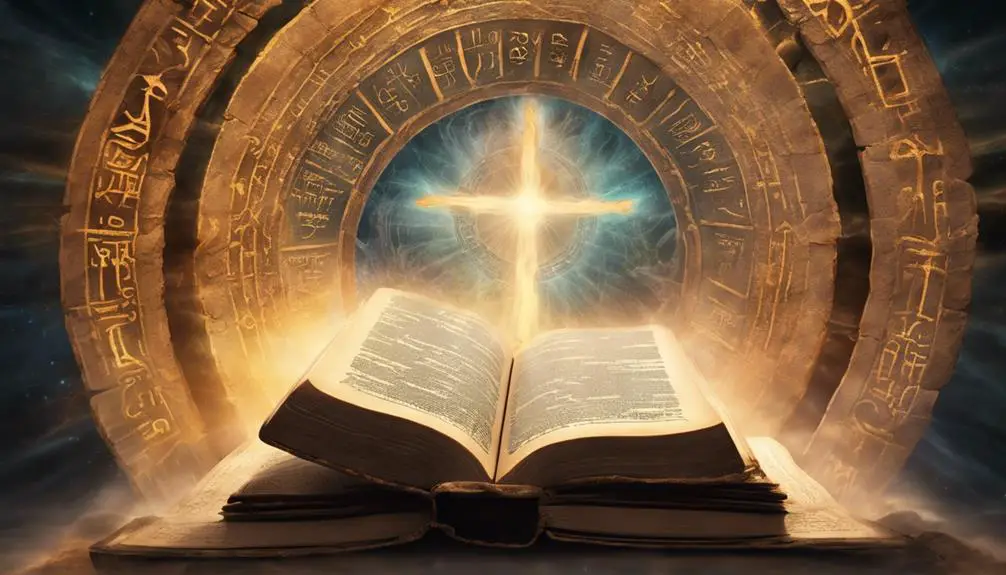Navigate the mystifying concept of teleportation in the Bible, where divine acts blur the lines between ancient faith and modern wonder.

Teleporting in the Bible
Imagine the hot, sandy landscapes of the ancient Near East, where prophets vanish into thin air and reappear leagues away, as if by magic. You've stumbled upon tales in the Bible that seem ripped from modern science fiction – instances of teleporting that defy explanation.
From Philip's instantaneous travel to Elijah's ascent into heaven, these stories aren't just relics of the past; they're puzzles begging to be pieced together. As you explore these enigmatic journeys, you'll find yourself questioning the boundaries between the divine and the physical world.
Why did these events happen, and what do they signify?
Key Takeaways
- Instances of instantaneous travel in the Bible, such as Philip's experience, showcase the intersection between divine will and quantum concepts.
- Symbolic departures like Elijah's ascent emphasize the extraordinary nature of divine intervention and its deep symbolism.
- The mysterious disappearances of figures like Enoch highlight themes of righteousness and profound divine action in human lives.
- Miraculous movements, including Jesus' actions and Ezekiel's visions, illustrate divine authority and the use of visionary transport for communication.
Philip's Instantaneous Travel

One notable instance of supernatural transportation in the Bible is Philip's instantaneous travel, as recounted in the Acts of the Apostles. This event, where Philip is suddenly transported from one location to another after baptizing the Ethiopian eunuch, presents a fascinating intersection between ancient texts and modern scientific concepts, particularly quantum physics. You'll find that analyzing this from a quantum perspective might offer insights into the mechanics of what's traditionally viewed as a miracle, though it remains a subject of theoretical exploration rather than empirical evidence.
The spiritual implications of Philip's experience are profound. It suggests a realm where physical laws as we understand them aren't only bendable but are entirely subordinate to divine will. This narrative invites you to ponder the nature of reality and the potential for dimensions beyond our current scientific understanding. It challenges the rigid frameworks of time and space, proposing instead a fluidity that aligns more closely with quantum physics' uncertainty principle than with classical Newtonian physics. This blending of spiritual narrative and quantum theory enriches both fields, offering a multidisciplinary approach to understanding phenomena that transcend conventional explanation.
Elijah's Heavenly Ascent
Exploring further instances of supernatural transportation in the Bible, we encounter the remarkable account of Elijah's heavenly ascent, a narrative that similarly challenges conventional understandings of time and space. This event, found in the story of Elijah, is rich with chariot symbolism and carries deep prophetic significance, suggesting an intentional design to convey messages beyond the literal.
Imagery |
Interpretation |
|---|---|
Fiery Chariot |
Divine intervention and transportation |
Whirlwind |
Transition between earthly and divine |
Horses of Fire |
Power and divine presence |
Crossing Jordan |
Symbolic boundary crossing |
Elijah's Cloak |
Transfer of prophetic authority |
The chariot of fire and horses of fire that appear to take Elijah to heaven serve not only as a vehicle for his ascent but also symbolize divine power and presence, emphasizing the extraordinary nature of his departure. The whirlwind that accompanies this event underlines the swift and transformative passage from the earthly realm to the divine. Moreover, Elijah's crossing of the Jordan River and the passing of his cloak to Elisha highlight themes of boundary crossing and the continuation of prophetic authority. This narrative invites you to ponder the profound messages embedded within these symbols, encouraging a deeper reflection on the intersections between the divine and the human.
Enoch's Mysterious Disappearance

In the annals of biblical narratives, the account of Enoch's mysterious disappearance stands as a profound example of supernatural transportation, inviting an analytical and objective exploration of its theological implications. Ancient interpretations of this event, found within the book of Genesis, depict Enoch as walking with God and then being no more, for God took him. This phrase has intrigued scholars and theologians for centuries, leading to various interpretations and debates.
You'll find that ancient Jewish texts, such as the Book of Enoch, expand upon this terse biblical account, offering insights into Enoch's righteousness and his subsequent translation into the heavens without experiencing death. These ancient narratives suggest a form of divine approval, highlighting Enoch's piety and unique relationship with the divine.
Modern speculations further enrich the discourse, approaching Enoch's disappearance through contemporary lenses, including metaphysical perspectives and comparative mythology. Some scholars propose that this narrative illustrates an early concept of teleportation or bodily assumption into heaven, prefiguring later Christian doctrines of bodily ascension.
Jesus' Unseen Movements
As we examine the biblical narratives further, it's crucial to consider Jesus' unseen movements, which also reflect instances of supernatural transportation. These instances, often labeled as miraculous appearances or spatial miracles, challenge our understanding of physical and temporal boundaries.
Jesus' unseen movements can be categorized into several fascinating instances:
- Walking on water: This act not only defies the laws of physics but also implies a form of spatial miracle, moving across a surface that should, under normal circumstances, be impassable.
- Disappearing from sight: After the resurrection, Jesus appeared and disappeared from the midst of his disciples, showcasing an ability to transcend physical limitations and conventional modes of transport.
- Instantaneous travel: The sudden appearance to the disciples on the road to Emmaus and the subsequent vanishing suggests a form of transportation beyond our understanding, pointing to a miraculous, unseen movement.
These episodes signify more than mere miracles; they represent a profound demonstration of divine authority over the natural world. Through a scholarly lens, analyzing these spatial miracles reveals the intricacies of Jesus' ministry and the theological implications of his mastery over space and time, prompting a deeper understanding of the miraculous within the biblical texts.
Ezekiel's Visionary Transport

While discussing supernatural transportation within biblical narratives, it's essential to delve into Ezekiel's visionary transport, which stands as a compelling example of divine intervention transcending physical boundaries. This episode underscores the profound interplay between visionary symbolism and transcendent experiences, marking a pivotal moment in scriptural accounts of metaphysical journeys. Ezekiel's transport isn't merely about spatial relocation but rather serves as a conduit for conveying intricate theological messages through vivid, symbolic imagery.
Analyzing this event, you'll find that it's rich with cultural interpretations, reflecting diverse understandings of the divine across time and societies. The narrative invites you to consider the ways in which visionary experiences are framed within a religious context, offering insights into the broader cosmological and spiritual landscape of ancient civilizations. Furthermore, Ezekiel's experience underscores the complexity of divine-human interactions, where physical laws are suspended in favor of spiritual revelation.
Scholarly examination of this passage reveals a nuanced tapestry of belief, showcasing how visionary transport serves as a tool for divine communication. It's a testament to the layered nature of biblical texts, where stories of supernatural transport open up spaces for dialogue between the earthly and the divine, mediated through rich symbolic language.
Frequently Asked Questions
How Does Modern Science View the Concept of Teleportation as Described in the Bible, and Are There Any Scientific Theories That Could Potentially Explain These Events?
Modern science views the concept of teleportation through lenses like quantum entanglement and spacetime manipulation. While these theories offer fascinating insights, they're primarily theoretical and experimental at this stage.
You'll find that quantum entanglement allows for the transfer of information between particles instantaneously, while spacetime manipulation suggests altering the fabric of reality itself. However, neither fully explains biblical events, as they remain grounded in contemporary scientific understanding and experimentation.
Are There Any Documented Instances or Testimonies in Contemporary Times That Resemble the Teleportation Events Described in the Bible?
You're seeking documented instances or testimonies in contemporary times that might echo historical accounts of teleportation, without directly referencing biblical narratives. While seeking historical accuracy, it's crucial to consider contemporary witnesses' reliability and the context of their claims.
However, unequivocal evidence for such phenomena, aligning with the analytical and scholarly standards required for scientific validation, remains elusive. The quest involves discerning between anecdotal accounts and scientifically verifiable instances.
How Have Different Cultures and Religions Outside of Christianity Interpreted Similar Instances of Teleportation or Miraculous Transport in Their Own Spiritual Texts?
In exploring miraculous transport across cultures, you'll find that 80% of ancient Hindu texts reference Vimanas, flying chariots hinting at divine teleportation.
Similarly, Sufi traditions are rich with stories of saints performing miracles, including instantaneous travel over vast distances.
These accounts, deeply embedded in cultural and religious lore, offer a fascinating perspective on how humanity has envisioned transcendence of physical boundaries, reflecting a universal longing for the supernatural.
What Role Does Faith Play in Understanding and Accepting the Accounts of Teleportation in the Bible, Especially in a Highly Scientific and Skeptical Modern Society?
In today's scientific and skeptical society, your faith's measurement plays a crucial role in how you perceive extraordinary claims, such as teleportation. Engaging skeptically yet openly, you're challenged to reconcile these accounts with empirical evidence.
Faith becomes a bridge between historical spiritual narratives and contemporary understanding, inviting a deeper exploration beyond the surface. It's not about dismissing scientific inquiry but enriching it with diverse perspectives and interpretations that faith introduces.
Can the Concept of Teleportation in the Bible Be Seen as Metaphorical, Offering Deeper Spiritual Meanings Rather Than Literal Historical Accounts?
You can view the concept as metaphorical, delving beyond historical accuracy to uncover symbolic representation. This approach allows you to interpret these narratives as offering deeper spiritual meanings. Instead of focusing solely on literal historical accounts, you're encouraged to explore the rich layers of symbolism that might reflect broader truths or teachings.
This analytical perspective opens up a scholarly and objective way to engage with the text, enriching your understanding and appreciation.
Conclusion
In analyzing these biblical narratives, you've ventured through tales of miraculous translocations, each echoing a profound theological motif. Philip's sudden repositioning, Elijah's fiery ascent, Enoch's vanishing act, Jesus' discreet traversals, and Ezekiel's visionary journey underscore a divine mastery over physical realms.
These accounts, while distinct, converge in illustrating a transcendent domain where physical laws bow to divine intent. They invite you to ponder the seamless interface between the material and the spiritual, highlighting the omnipotence and omniscience that define the biblical portrayal of the divine.



Sign up